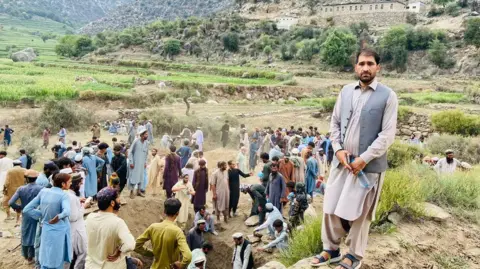Just before midnight on Sunday, Matiullah Shahab woke up to find his house in Afghanistan's remote Kunar province shaking. An earthquake measuring 6.0 magnitude had struck eastern Afghanistan, leaving at least 800 people dead, according to the UN. Even though the epicentre of the quake was 16km away, the whole of Shahab's village of Asadabad trembled. The 23 family members who live with him ran out of their bedrooms as they feared the walls would fall in on them, and stayed awake all night in their garden. We were all afraid, he says.
The areas worst hit by the quake were Nangarhar and Kunar provinces, but it was felt as far away as Kabul and in neighbouring Pakistan's capital Islamabad. When day broke, Matiullah - who is a freelance journalist and human rights activist - drove from his home to try to reach the remote mountainous area at the epicentre of the quake. He says he had to get out of his car and walk for two hours before he arrived at the worst-hit villages as there were rocks on the road.
Upon arriving in the village of Andarlachak, he found several young children being treated by medics in the street, with some covered in white sheets. Tragically, 79 people died in that village alone. I saw many dead bodies, says Matiullah. I felt the aftershocks 17 times.
Matiullah helped the local community dig graves for the deceased, noting the sheer devastation in the villages he visited. Many residents, still in shock, had faces covered in dust and seemed unable to speak. Rescue operations, hindered by blocked roads, have had to rely on helicopters, with reports of survivors trapped beneath rubble.
In Kunar's Sokai district, resident Ezzatullah Safi described the chaos as his house collapsed, relaying the fear and despair felt by families. Government helicopters have begun airlifting the injured to safer locations for medical care. The surrounding communities, reeling from the heartbreaking loss, now face the challenge of rebuilding amidst ongoing grief.
The areas worst hit by the quake were Nangarhar and Kunar provinces, but it was felt as far away as Kabul and in neighbouring Pakistan's capital Islamabad. When day broke, Matiullah - who is a freelance journalist and human rights activist - drove from his home to try to reach the remote mountainous area at the epicentre of the quake. He says he had to get out of his car and walk for two hours before he arrived at the worst-hit villages as there were rocks on the road.
Upon arriving in the village of Andarlachak, he found several young children being treated by medics in the street, with some covered in white sheets. Tragically, 79 people died in that village alone. I saw many dead bodies, says Matiullah. I felt the aftershocks 17 times.
Matiullah helped the local community dig graves for the deceased, noting the sheer devastation in the villages he visited. Many residents, still in shock, had faces covered in dust and seemed unable to speak. Rescue operations, hindered by blocked roads, have had to rely on helicopters, with reports of survivors trapped beneath rubble.
In Kunar's Sokai district, resident Ezzatullah Safi described the chaos as his house collapsed, relaying the fear and despair felt by families. Government helicopters have begun airlifting the injured to safer locations for medical care. The surrounding communities, reeling from the heartbreaking loss, now face the challenge of rebuilding amidst ongoing grief.



















